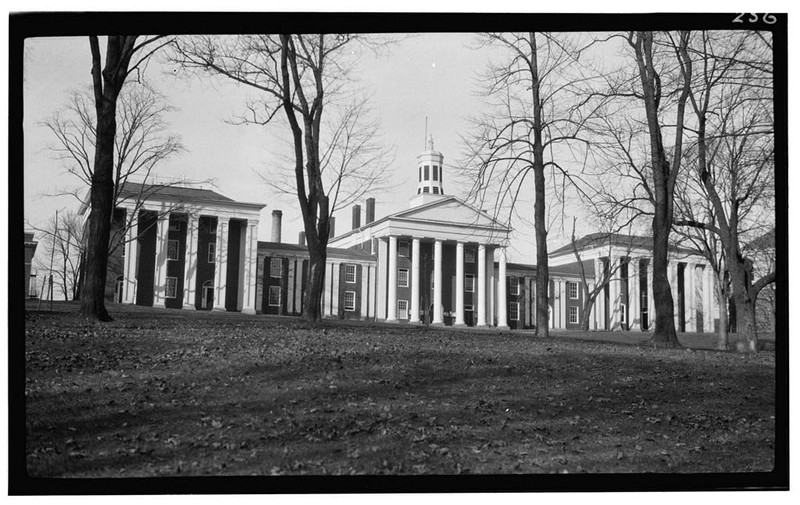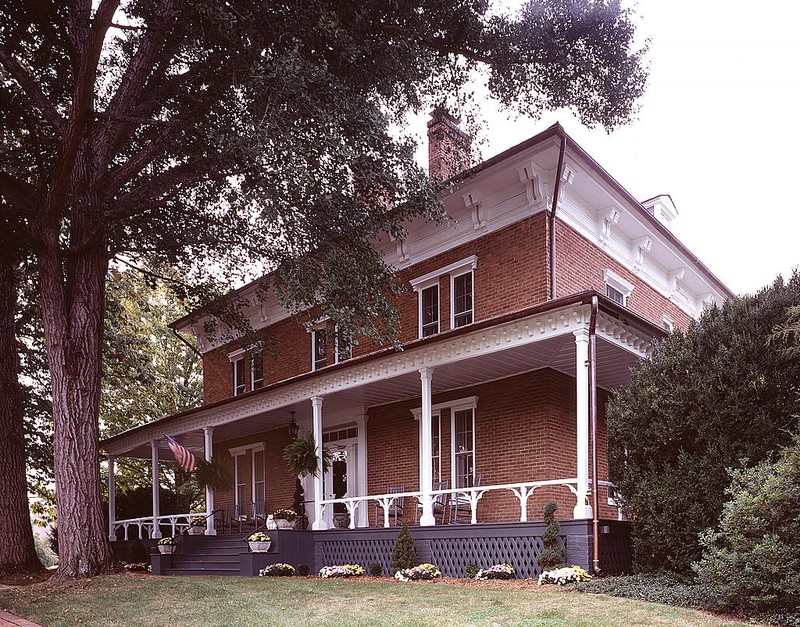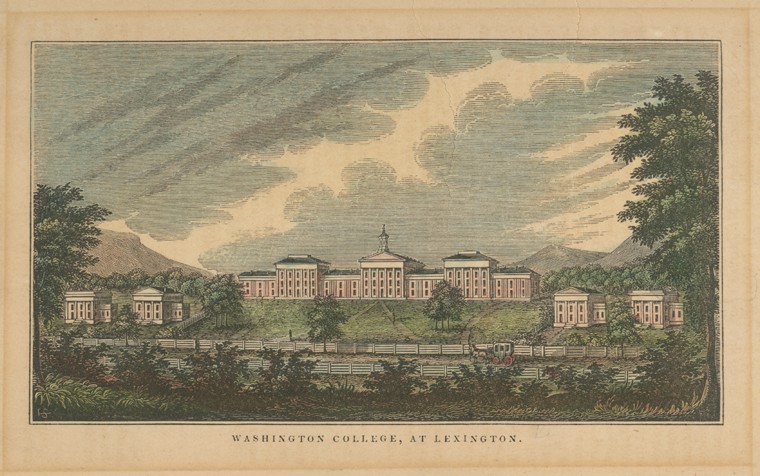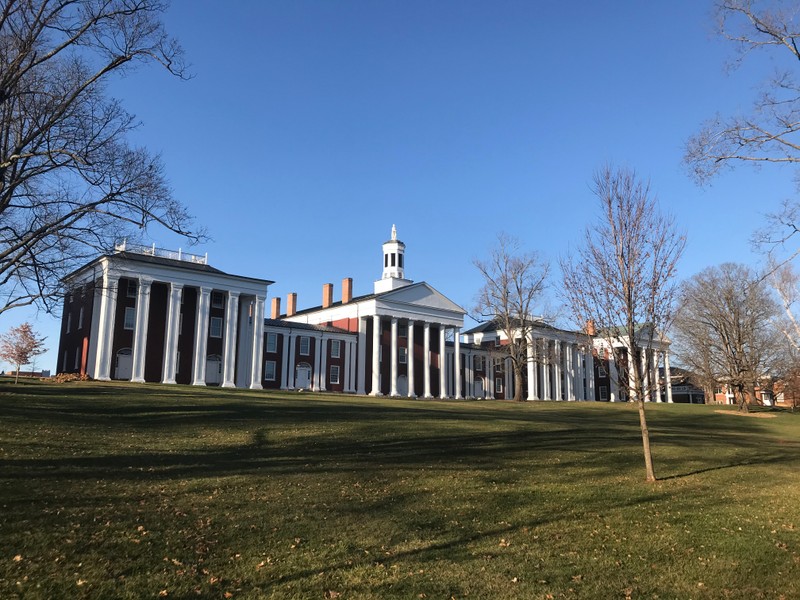Washington and Lee University Historic District
Introduction
Text-to-speech Audio
Images
Payne, Washington, and Chavis (formerly Robinsons) Halls, July 1967

Lee House (President's House)

1845 Lithograph by Henry Howe

Payne, Washington, Chavis (formerly Robinson), and Tucker Halls

Backstory and Context
Text-to-speech Audio
“No more impressive expression of the educational ideals of the time could be imagined than this Classic group, its pediment and orders seen through embowering trees, over swelling American lawns, its cupola crowned with the image of the Pater Patriae.”[19] – Architectural historian Talbot Hamlin, in Greek Revival Architecture in America.
Washington and Lee’s historic central campus, as described in this quotation, today consists of nine buildings. Though mostly architecturally congruent, the mix of educational and residential structures was in fact built over a nearly-150-year period between 1822 and 1936. The earliest, Washington Hall, was designed by self-taught builder/architect John Jordan and constructed out of brick made on campus between 1822 and 1824. Its roof was altered and the cupola was added in 1842-44. Matthew Kahle, a Lexington artisan, sculpted an 8-foot, 700-lb statue of George Washington out of a single log; christened “Old George,” it was hoisted to the top of the cupola in 1844 (it was replaced by a bronze copy in 1990). Washington Hall was originally known as the Center Building, as it sat between Graham and Union Halls (built 1804), both of which were demolished to make space for two larger buildings. The west of these larger buildings, the Lyceum (now Payne Hall), was constructed in 1830-31; the east, Robinson, was built between 1840-43. Two other dorms were built further to the east and west but were demolished in the 1880s, most likely to make space for Newcomb Hall, which was built to the west in 1881. Its eastern counterpart was Tucker Hall, built out of stone in the Gothic style in 1900 as a home for the law school. This building burnt in 1934 and an architecturally corresponding replacement was completed in 1936, also named Tucker. All of the central buildings, which now formed part of a Colonnade – or “symmetrical line of columns” – were completely renovated in 1935-36; no original interior was left.[13] These buildings were also given official names: Washington, after Old George; Payne, after a major renovation donor; and Robinson, after an early donor and trustee who left his estate (including 73-84 slaves) to the college in 1826. All of these buildings were brought up to modern standards between 2009 and 2014; they are still used and house many offices and academic departments.
The remaining four buildings include Lee Chapel, covered in a separate Clio entry, and three faculty dwellings – Morris, Simpson, and Lee Houses. Morris and Simpson were two of four faculty houses built in the early 1840s; Simpson (formerly known as Lee-Jackson) served as the President’s house until 1869 and was the home of Stonewall Jackson for several years in the 1850s (after he married the President’s daughter). The Lee House was designed by Robert E. Lee (then University President) and completed in 1869; its wide porches were constructed for his wheelchair-bound wife. Lee himself died in the house in 1870 and it still serves as the University President’s official dwelling.
As for the University itself, it was Washington Academy when it moved to Lexington in 1803 after a series of catastrophic fires and was not officially called “Washington College” until 1813. (See the Clio entry “Liberty Hall Academy Ruins” for more information on the school’s preceding history.) The school managed to survive high tensions and near- destruction in the Civil War; Unionist President George Junkin was forced to flee by students and faculty after Virginia’s secession, and, according to legend, only the statue of “Old George” atop Washington Hall saved the school from ruin during a Union raid in 1864 (neighboring VMI was not so lucky). In fact, the students' support for the Confederacy went so far as forming the “Liberty Hall Volunteers,” a company that fought as part of the Stonewall Brigade and was with Lee at Appomattox. After the war, and with few repairs completed from wartime vandalism, the Board of Trustees selected Robert E. Lee as president. He successfully took the school from subsisting as a tiny and struggling college to entering the national stage as a top-tier liberal arts university. Upon his death in 1870, the College’s name was changed to Washington and Lee University and Lee’s son succeeded him as President. The school’s first African American students in 150 years matriculated in 1966 and it became co-educational in 1985. Today, it is famous for its achievements, including the first college Journalism education program, and its longstanding traditions, such as the student-led Honor System, the “Speaking Tradition” of greeting others, the Fancy Dress Ball (established in 1907), and the Mock Convention (since 1908, it has successfully predicted the non-incumbent party’s presidential candidate 20 out of 26 times).
In recent years, calls have been made to rename several buildings on the University’s campus and further disassociate it from the Confederate South and the Lost Cause movement that arose in the following decades. These movements have resulted in the renaming of the Lee-Jackson House after Pamela Hemingway Simpson, the first tenured female W&L professor and an instrumental leader in the school’s move to co-education, and of Robinson Hall after John Chavis, who graduated from W&L in 1799 and was “the first known African-American to receive a college education in the United States.”[4] In July 2020, during the nationwide George Floyd protests, the executive committee of the student body and a vast majority of the faculty voted to remove Lee from the University's name; the issue then passed to a special committee created by the Board of Trustees.
Sources
1) 117-0022 Washington and Lee University Historic District, DHR: Virginia Department of Historic Resources. Accessed February 12th 2020. https://www.dhr.virginia.gov/historic-registers/117-0022/.
2) A Brief History - History and Traditions - About W&L - Home, Washington & Lee. Accessed February 12th 2020. https://my.wlu.edu/about-wandl/history-and-traditions/a-brief-history.
3) Adams, Susan. Washington And Lee Faculty Vote To Remove ‘Lee’ From University’s Name, Forbes. July 7th 2020. Accessed August 17th 2020. https://www.forbes.com/sites/susanadams/2020/07/07/washington-and-lee-faculty-vote-to-remove-lee-from-universitys-name/#73db191a7c87.
4) African Americans at Washington and Lee: A Timeline - Working Group on African-American History - Institutional History - Issues and Initiatives - President's Office - Home, Washington & Lee. Accessed February 12th 2020. https://my.wlu.edu/presidents-office/issues-and-initiatives/institutional-history/working-group-on-african-american-history/timeline-of-african-americans-at-wandl.
5) Bell, Elizabeth. Amid calls for change, Washington and Lee University committee to review school's name, The News & Advance. July 8th 2020. Accessed August 17th 2020. https://newsadvance.com/news/state-and-regional/amid-calls-for-change-washington-and-lee-university-committee-to-review-schools-name/article_456a64a4-f851-54d0-8758-06d4de4bfd3f.html.
6) Chavis Hall (Chavis_Brochure.pdf), Washington & Lee. Accessed February 12th 2020. https://my.wlu.edu/Documents/president/AfricanAmerican/Chavis_Brochure.pdf.
7) Completed - Projects - Capital Projects - University Facilities - Home, Washington & Lee. Accessed February 12th 2020. https://my.wlu.edu/university-facilities/capital-projects/projects/completed.
8) Eckert, Brian. Copy of “Old George” Joins Museum of the Shenandoah Valley Exhibit, Washington and Lee University. April 22nd 2014. Accessed February 12th 2020. http://news.blogs.wlu.edu/2014/04/22/copy-of-old-george-joins-museum-of-the-shenandoah-valley-exhibit/. Internet Archive. February 7th 2016. https://web.archive.org/web/20160207151404/http://news.blogs.wlu.edu/2014/04/22/copy-of-old-george-joins-museum-of-the-shenandoah-valley-exhibit/.
9) Gilliam, McCluer. Photographs: Written Historical and Descriptive Data - Washington and Lee University, Washington Hall (Center Building) - HABS No. VA-568-A, Library of Congress. February 13th 1969. Accessed February 12th 2020. https://cdn.loc.gov/master/pnp/habshaer/va/va0900/va0909/data/va0909data.pdf.
10) Historic American Buildings Survey. Washington & Lee University, Washington Hall, Jefferson Street, Lexington, Lexington, VA, Library of Congress. Accessed February 12th 2020. https://www.loc.gov/pictures/item/va0909/.
11) Historic American Buildings Survey. Washington & Lee University, Lee-Jackson House, 4 University Place, Lexington, Lexington, VA, Library of Congress. Accessed February 12th 2020. https://www.loc.gov/pictures/item/va0901/.
12) History of the School of Law - Leadership - About W&L Law - Homepage, Washington and Lee University School of Law. Accessed February 12th 2020. https://law.wlu.edu/about-wandl-law/leadership/history.
13) Interactive Campus Map: entries for Lee House, Simpson House, Morris House, Newcomb Hall, Payne Hall, Washington Hall, Chavis Hall, and Tucker Hall , Washington and Lee University. Accessed February 12th 2020. https://campusmap.wlu.edu/.
14) Null, Druscilla J. Written Historical and Descriptive Data - Washington and Lee University, Lee-Jackson House - HABS No. VA-568-B , Library of Congress. August 31st 1983. Accessed February 12th 2020. https://cdn.loc.gov/master/pnp/habshaer/va/va0900/va0901/data/va0901data.pdf.
15) Our Name - History - The W&L Story - Home, Washington & Lee. Accessed February 12th 2020. https://www.wlu.edu/the-w-l-story/history/our-name/.
16) Our Traditions - History and Traditions - About W&L - Home, Washington & Lee. Accessed February 12th 2020. https://my.wlu.edu/about-wandl/history-and-traditions/our-traditions.
17) Selbe, Nick. The 25 Oldest Colleges in America, tucson.com. December 15th 2015. Accessed February 12th 2020. https://tucson.com/news/data/the-oldest-colleges-in-america/article_06a340db-02a9-5e01-8729-6751d05287d6.html.
18) University Chronology - A Brief History - History and Traditions - About W&L - Home, Washington & Lee. Accessed February 12th 2020. https://my.wlu.edu/about-wandl/history-and-traditions/a-brief-history/university-chronology.
19) Virginia Historic Landmarks Commission Staff. Washington and Lee University Historic District, National Register of Historic Places Inventory/Nomination Form, Virginia Department of Historic Resources. December 18th 1970. Accessed February 12th 2020. https://www.dhr.virginia.gov/wp-content/uploads/2018/04/117-0022_WashingtonLeeHD_1970_NRHP_Final.pdf.
20) Washington and Lee University – Tucker Hall Renovation, Engineering Economics, Inc. Accessed February 12th 2020. https://www.eeiengineers.com/project/washington-and-lee-university-tucker-hall-renovation/.
21) What is Mock Convention?, The 27th Washington and Lee Mock Convention. Accessed February 12th 2020. https://www.mockconvention.com/what-is-it.
22) Wongsrichanalai, Kanisorn. Washington College during the Civil War, Encyclopedia Virginia: Virginia Humanities. October 27th 2015. Accessed February 12th 2020. https://www.encyclopediavirginia.org/Washington_College_During_the_Civil_War.
https://www.loc.gov/pictures/item/va0908.photos.165399p/
https://en.wikipedia.org/wiki/File:President%27s_House_Washington_and_Lee_Lexington_Virginia.jpg
https://en.wikipedia.org/wiki/File:Washington_College_Lexington_Virginia_1845.jpeg
Author (Benjamin Woodard)
